Big bugs
Did you know that the world's largest millipede is the length of a strand of spaghetti? Or that one of the longest beetles on the planet can snap a pencil with its powerful jaws? Discover some of the world's biggest bugs with Museum insect expert George Beccaloni, author of the book Big Bugs Life-Size.
Record breakers
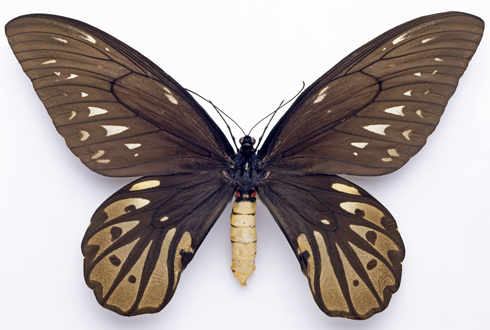
World's biggest butterfly
Queen Alexandra's birdwing butterfly, Ornithoptera alexandrae
Maximum wingspan: 27.3cm (adult female)
Distribution: southeastern Papua New Guinea (Oro province)
As well as having the greatest wingspan of all the world’s 20,000 butterfly species, this species probably also has the heaviest caterpillar.
The colouration of the females enables them to blend in well with the dappled shade of the rainforest as they fly lower down in search for food-plants for their larvae. Like most butterfly species, the males are more colourful, with vivid blue-green iridescent colouration on their wings.
Find out more about Queen Alexandra's birdwing in our species factfile
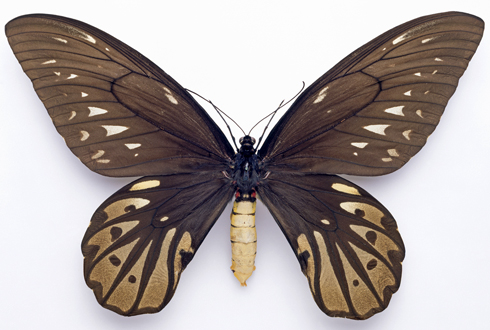
Queen Alexandra's birdwing butterfly, Ornithoptera alexandrae
The world's biggest butterfly. A maximum wingspan of 27.3cm has been recorded for an adult female. This species probably also has the heaviest caterpillar (HOW HEAVY?) of all the world’s 20,000 butterfly species.
Distribution: southeastern Papua New Guinea (Oro province)
Find out more about Queen Alexandra's birdwing butterfly in our species factfile >
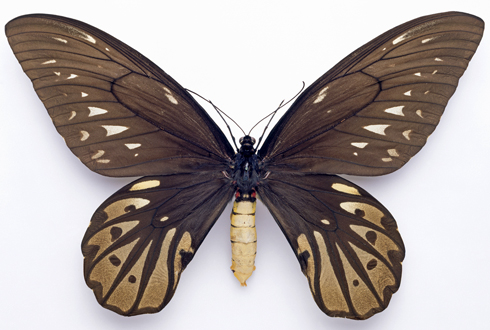
The world's biggest butterfly: Queen Alexandra's birdwing butterfly
Maximum wingspan: 27.3cm (adult female)
Scientific name: Ornithoptera alexandrae
Distribution: Oro province, southeastern Papua New Guinea
This species probably also has the heaviest caterpillar (HOW HEAVY?) of all the world’s 20,000 butterfly species.
Find out more about Queen Alexandra's birdwing butterfly in our species factfile >
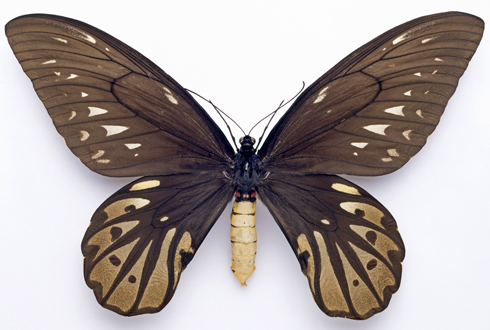
World's biggest butterfly
Queen Alexandra's birdwing butterfly, Ornithoptera alexandrae
Maximum wingspan: 27.3cm (adult female)
Distribution: southeastern Papua New Guinea (Oro province)
As well as having the greatest wingspan of all the world’s 20,000 butterfly species, the Queen Alexandra's birdwing butterfly probably also has the heaviest caterpillar (HOW HEAVY?).
Find out more about Queen Alexandra's birdwing butterfly in our species factfile >
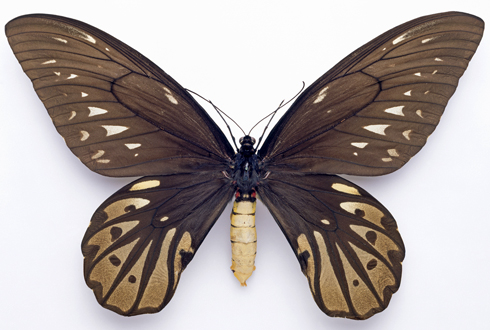
Queen Alexandra's birdwing butterfly, Ornithoptera alexandrae
The world's biggest butterfly
Maximum wingspan: 27.3cm (adult female)
Distribution: southeastern Papua New Guinea (Oro province)
As well as the greatest wingspan, the Queen Alexandra's birdwing butterfly probably also has the heaviest caterpillar of all the world's 20,000 butterfly species.
The colouration of the females enables them to blend in well with the dappled shade of the rainforest when they fly lower down in search for food-plants for their larvae. The males are more colourful, with vivid blue-green iridescent colouration on their wings.
Find out more about Queen Alexandra's birdwing butterfly in our species factfile >
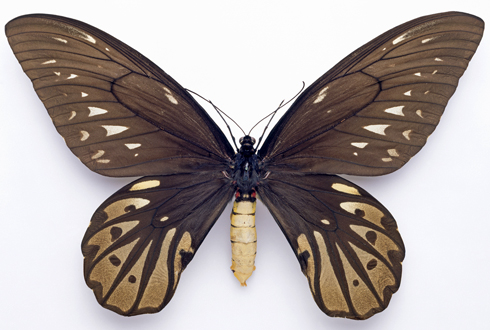
World's biggest butterfly
Record holder: Queen Alexandra's birdwing butterfly, Ornithoptera alexandrae
Maximum wingspan: 27.3cm (adult female)
Distribution: southeastern Papua New Guinea (Oro province)
As well as having the greatest wingspan of all the world’s 20,000 butterfly species, this species probably also has the heaviest caterpillar.
Like most butterfly species, the males are more colourful than the females, with vivid blue-green iridescent colouration on their wings. The black and white colouration of females enables them to blend in well with the dappled shade of the rainforest, as they fly lower down in search for food-plants for their larvae.
Find out more about Queen Alexandra's birdwing butterfly in our species factfile >
What is a bug?
According to entomologists, bugs are insects with mouthparts adapted for sucking up liquids. They belong to a large group of species called the Hemiptera. Examples are bed bugs, aphids and cicadas. However, the word bug is often used to refer to any insect.
The book Big Bugs Life-size also includes the largest representatives of arachnids (spiders and their relatives) and myriapods (centipedes and millipedes). Insects, arachnids and myriapods are all part of the group called arthropods (animals that have external skeletons and jointed legs).
Measuring bugs
What is meant by biggest?
The best measure of the size of a bug is its body weight when alive. But this is not the only way of identifying a big bug. Other record breakers have the greatest body length or the largest wingspan.
A bug’s body length is measured in a straight line from the tip of its mandibles (jaws) or the longest forward-projecting horn, to the end of its body.
Wingspan is calculated as twice the distance from the tip of the wing to its base in a straight line, plus the distance between the bases of the wings. This means that you get the same result whatever position the wings are arranged in.
Potential problems
There are many problems with measuring the length of bugs. Sometimes they can be stretched, deliberately or not. Or they can shrink after death, which is a common problem with soft-bodied species.
Weight can also be a problem. Weighing dead specimens will give an underestimate because the body contents will have dried out or rotted away.
About the author
George Beccaloni started collecting and studying insects at the age of 10 whilst he was living in Zimbabwe, Africa. During his PhD on South American butterflies, he spent almost a year doing fieldwork in the Ecuadorean rainforest where he encountered a lot of bugs, including a few of the giants featured in Big Bugs Life-size.
George has worked in the Natural History Museum’s Entomology Department since 1996 and as Curator of Orthopteroid Insects (grasshoppers, crickets, cockroaches, stick insects and their relatives) since 2003. He is the author of many popular and scientific articles, as well as 4 other books.
Big Bugs Life-size, new book
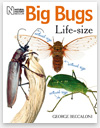
Enter a world of winged wonders, enormous earwigs and super-sized scorpions with Big Bugs Life-size.
It is the first book to feature life-size photographs of all the world’s largest and most spectacular bugs.